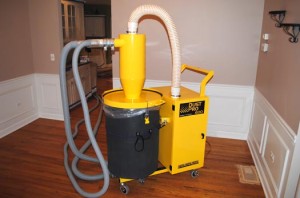 Sanding a hardwood floor using an industrial sander is going to produce unbelievable amounts of dust. This dust will find it’s way into every nook and cranny of your home. The contractor or the homeowner could use an industrial vacuum while sanding with a vacuum attachment. In addition the dust floats through the air. It will permeate the home, it also stays in the room you are sanding. Obtaining a perfect finish to the floor while you are apply a protective urethane or whatever finish you use is almost impossible.
Sanding a hardwood floor using an industrial sander is going to produce unbelievable amounts of dust. This dust will find it’s way into every nook and cranny of your home. The contractor or the homeowner could use an industrial vacuum while sanding with a vacuum attachment. In addition the dust floats through the air. It will permeate the home, it also stays in the room you are sanding. Obtaining a perfect finish to the floor while you are apply a protective urethane or whatever finish you use is almost impossible.
Spec’s of dust will land on the floor before it has a chance to dry. Suddenly you have all of these dust marks that have now dried into the finish. Use a vacuum attached to the sander to remove over 90% of the dust to an outside dust collector. Then use a tact cloth to capture the remaining dust on the floor and the walls.
Dustless Hardwood FloorRefinishing
Even if you sand by hand, which is very hard work, dust will be stirred up as you walk around. Although not as messy you are still going to find dust in all of the wrong places. The dust adheres to clothes and is picked up by the least bit of draft. It spreads throughout the house in no time at all.
If you have a forced air furnace, make sure that you always turn the furnace off before you begin dusting. With the fan on or when the furnace comes on to heat the house, the dust from sanding is literally going to be picked up and blown throughout the house. The filter on your furnace will catch some of it. But the finer particles will get through and be blown throughout your home. If you do not mind dusting, I guess it would be ok. But that is not what we are looking to spend our time doing.
Use a Dustless Floor Sander When Refinishing Hardwood Floors
Attaching an industrial vacuum to your sander is by far the best approach to sanding hardwood floors. These vacuums will suck almost 100% of the dust out of the room and collect it in a canister outside your home. There will be very little dust remaining inside your home and no dusting needed. In addition with no suspended particles in the air to fall on a wet floor while it is being coated with whatever finish you plan to use, there will be an almost perfect finish to the floor.
Always make sure that the vacuum that is being used with the sander is vented outside of your home. If you do not do this, you are really defeating the purpose of using a vacuum in the first place. Although the filter in the vacuum will capture many of the dust particles, some of the micro particles are going to get through and be distributed inside your home. Venting the vacuum outside will make sure that this dust goes outside and stays outside.
Still Need to Clean
The work you avoid in terms of cleaning and dusting after words will also be appreciated by your spouse. No one wants to have to dust everything and we mean absolutely everything, including the curtains or blinds and even the walls. Avoiding this kind of work is by far a superior approach. It might cost a bit more to use a dustless sander, but compared to doing all of the cleaning after words, the extra cost will be well worth it.
The amount of dust is significantly reduced, however consumers should be aware that there still may be a fine dusting of wood particles on your furniture etc, so be prepared to do some dusting after the floor is finished.
Most people will have to do some dusting in their homes after sanding, but the more steps you take to limit the dust generation and distribution, the less you will have to work afterwords to clean everything up.